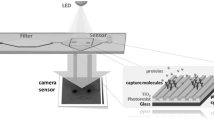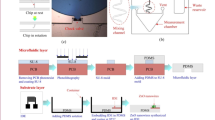Abstract
In this paper, an integrated fiberoptic–microfluidic device for the detection of agglutination for blood type cross-matching has been described. The device consists of a straight microfluidic channel through with a reacted RBC suspension is pumped with the help of a syringe pump. The flow intersects an optical path created by an emitter-received fiber optic pair integrated into the microfluidic device. A 650 nm laser diode is used as the light source and a silicon photodiode is used to detect the light intensity. The spacing between the tips of the two optic fibers can be adjusted. When fiber spacing is large and the concentration of the suspension is high, scattering phenomenon becomes the dominant mechanism for agglutination detection while at low concentrations and small spacing, optointerruption becomes the dominant mechanism. An agglutination strength factor (ASF) is calculated from the data. Studies with a variety of blood types indicate that the sensing method correctly identifies the agglutination reaction in all cases. A disposable integrated device can be designed for future implementation of the method for near-bedside pre-transfusion check.

























Similar content being viewed by others
References
S.P. Alexander, Master’s Thesis, North Carolina State University, Raleigh, NC, USA (2007)
S.R. Anthony, Master’s Thesis, North Carolina State University, Raleigh, NC, USA (2005)
P.P. Dujardin, L.R. Salmi, P. Ingrand, Vox Sanguinis 78, 37–43 (2000)
W. Dzik, Transfusion 43, 1190–1199 (2003)
Encyclopedia Britannica, “Rh blood group system,” from Encyclopædia Britannica Online: http://www.britannica.com/eb/article-9063395, retrieved October 2 (2007)
P. Ingrand, N. Surer-Pierres, D. Houssay, L.R. Salmi, Transfusion 38, 1030–1036 (1998)
J.B. Lambert, Master’s Thesis, North Carolina State University, Raleigh, NC, USA (2006)
J.V. Linden, K. Wagner, A.E. Voytovich, J. Sheehan, Transfusion 40, 1207–1213 (2000)
V. Migeot, I. Ingrand, R.L. Salmi, P. Ingrand, Transfusion 42, 1348–1355 (2002)
J. Murakami, Rinsho Byori 51, 43–49 (2003)
B.A. Myhre, D. McRuer, Transfusion 40, 879–885 (2000)
S. Narayanan, S. Orton, G.F. Leparc, L.H. Garcia-Rubio, R.L. Potter, Transfusion 39, 1051–1059 (1999)
S. Narayanan, L. Galloway, A. Nonoyama, G. Leparc, L.H. Garcia-Rubio, R.L. Potter, Transfusion 42, 619–626 (2002)
M.K. Nilsson, P. Alsholm, A. Karlsson, S. Andersson-Engels, Appl Optics 37(13), 2735–2748 (1998)
H.A. Oberman, The present and future crossmatch Transfusion 32, 794–796 (1992)
M. Prakash, C.K. Arora, Physiology of Blood (Anmol, New Delhi, 1998)
E.D. Quinley, Immunohematology: Principles and Practice, 2nd edn (Lippincott-Raven, Philadelphia, 1998)
M.K. Ramasubramanian, S.R. Anthony, J. Lambert, Applied Optics 47, 4094–4105 (2008)
K. Sazama, Transfusion errors: scope of the problem, consequences, and solutions Curr. Hematol. Reports 2, 518–521 (2003)
Acknowledgements
The authors would like to thank Dr. Glenn Walker of NC State University Biomedical Engineering Department for allowing us to use his laboratory facilities for fabricating the microfluidic device and offering expert advice on device fabrication. We would like to thank Mr. Don Bennett of Duke University Hospital Transfusion Services for all his support and supply of RBC samples when needed, and Dr. Ranga Krishnan, of Duke University Medical center, for supporting this study.
Author information
Authors and Affiliations
Corresponding author
Rights and permissions
About this article
Cite this article
Ramasubramanian, M.K., Alexander, S.P. An integrated fiberoptic–microfluidic device for agglutination detection and blood typing. Biomed Microdevices 11, 217–229 (2009). https://doi.org/10.1007/s10544-008-9227-y
Published:
Issue Date:
DOI: https://doi.org/10.1007/s10544-008-9227-y




